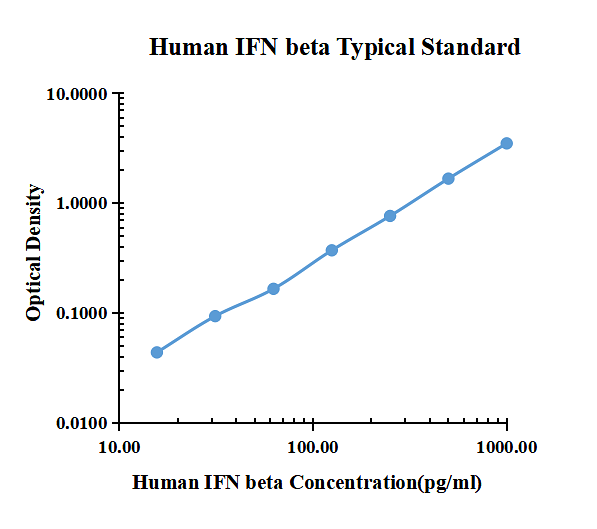Human IFN-β enzyme-linked immunoassay kit
| Specification | 96 Test |
|---|---|
| Sensitivity | 0.35 pg/ml (50 μl) |
| Standard Curve Range | 15.63~1000 pg/ml |
| Standard Curve Gradient | 7 Points |
| Number of Incubations | 2 |
| Detectable sample | Liquid phase sample of soluble substances. For example: serum, plasma, cell culture supernatant, tissue grinding liquid, etc. |
| Sample Volume | 50 μl |
| Type | Fully Ready-to-Use |
| Operation Duration | 120min |

| pg/ml | O.D. | Average | Corrected | |
|---|---|---|---|---|
| 0.00 | 0.0349 | 0.0318 | 0.0334 | |
| 15.63 | 0.0798 | 0.0747 | 0.0773 | 0.0439 |
| 31.25 | 0.1220 | 0.1323 | 0.1272 | 0.0938 |
| 62.50 | 0.2001 | 0.1991 | 0.1996 | 0.1663 |
| 125.00 | 0.3930 | 0.4183 | 0.4057 | 0.3723 |
| 250.00 | 0.8126 | 0.7841 | 0.7984 | 0.7650 |
| 500.00 | 1.7670 | 1.6420 | 1.7045 | 1.6712 |
| 1000.00 | 3.5520 | 3.5080 | 3.5300 | 3.4967 |
Precision
| Intra-assay Precision | Inter-assay Precision | |||||
| Sample Number | S1 | S2 | S3 | S1 | S2 | S3 |
| 22 | 22 | 22 | 6 | 6 | 6 | |
| Average(pg/ml) | 20.0 | 99.1 | 304.4 | 21.3 | 101.4 | 317.2 |
| Standard Deviation | 1.2 | 5.8 | 14.3 | 1.5 | 4.2 | 15.7 |
| Coefficient of Variation(%) | 6.2 | 5.9 | 4.7 | 7.1 | 4.1 | 5.0 |
Intra-assay Precision (Precision within an assay) Three samples of known concentration were tested twenty times on one plate to assess intra-assay precision.
Inter-assay Precision (Precision between assays) Three samples of known concentration were tested six times on one plate to assess intra-assay precision.
Spike Recovery
The spike recovery was evaluated by spiking 3 levels of human IFN beta into health human serum sample. The un-spiked serum was used as blank in this experiment.
The recovery ranged from 102% to 129% with an overall mean recovery of 121%.
Sample Values
| Sample Matrix | Sample Evaluated | Range (pg/ml) | Detectable (%) | Mean of Detectable (pg/ml) |
|---|---|---|---|---|
| Serum | 30 | n.d.-2.08 | 53 | 1.03 |
Serum/Plasma – Thirty samples from apparently healthy volunteers were evaluated for the presence of IFN-β in this assay. No medical histories were available for the donors.
Product Data Sheet
Background: IFN-β
Interferon-beta (IFN-beta) is a cytokine that is produced by fibroblasts and pathogen-exposed dendritic cells, macrophages, and endothelial cells. It signals through the heterodimeric IFN-alpha/beta Receptor. IFN-beta-deficient mice show increased susceptibility to experimental autoimmune encephalomyelitis (EAE), a disease model of human multiple sclerosis (MS). Furthermore, IFN-beta has been shown to suppress the Th17 cell response in both MS and EAE and has commonly been used as a treatment for MS.

